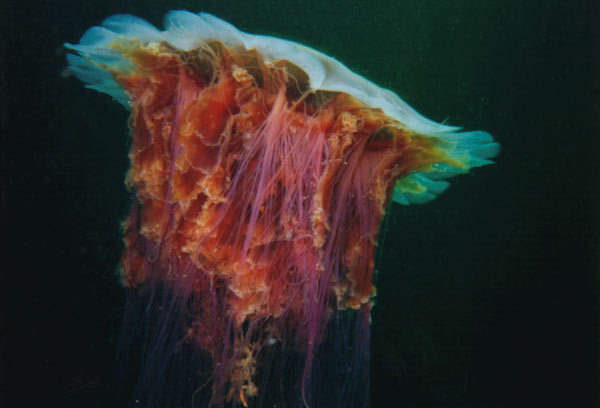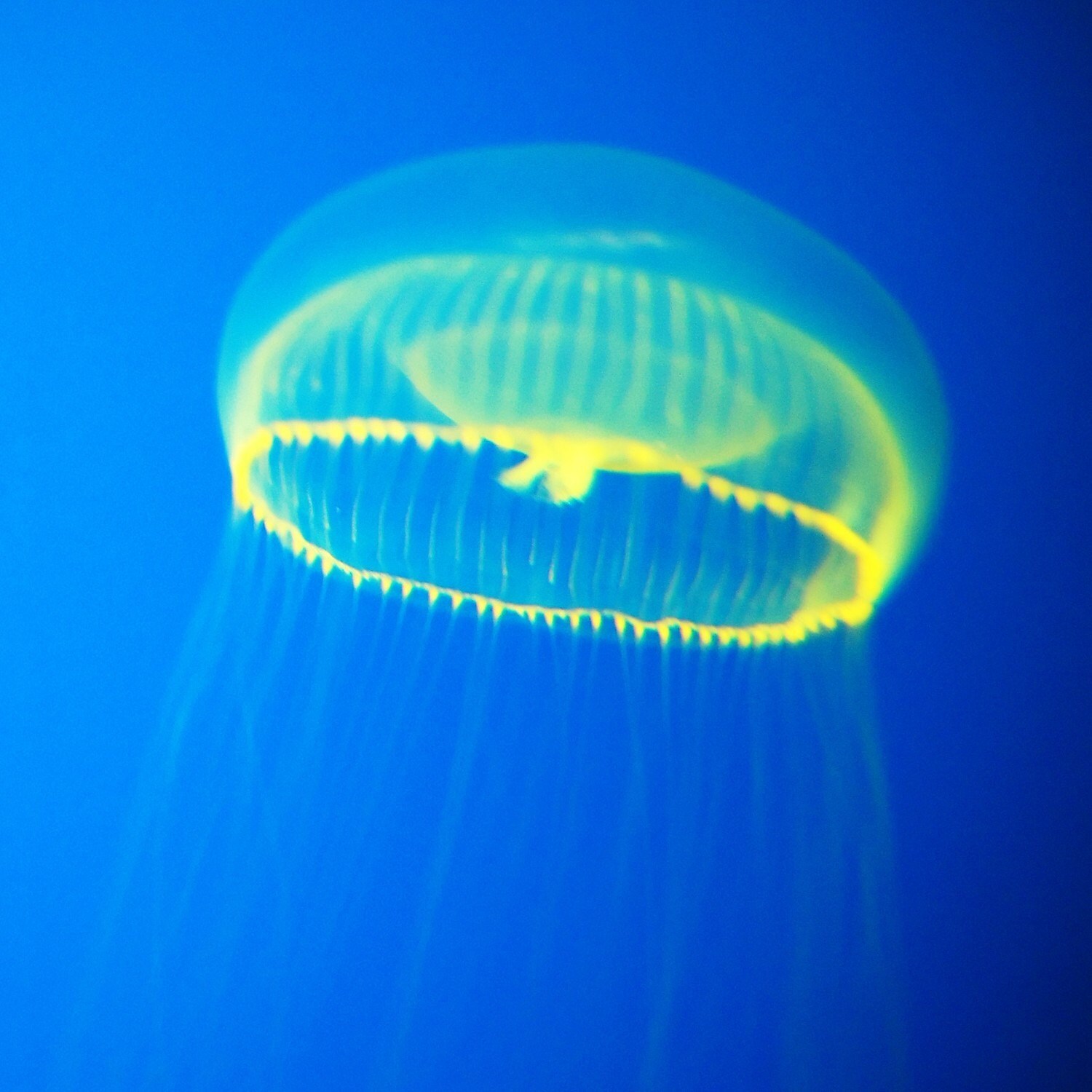So, you want to learn about Jellyfish huh? You want to know how a creature with no brain, no bones and no internal organs can survive right? Well this is where you can get all your questions answered! This is strictly for all Jellyfish breeds, known and unknown to most of us, now shall we get started? The information I will be posting down came from this site:
JELLYFISH SPECIES.
The Maingrove Jellyfish: Mangrove jelly fish (Cassiopea xamachana) is so called because it is mostly found in the roots of mangroves in the southern Gulf of Mexico, Caribbean, and other tropical waters. They are also called the Upside Down jellyfish because they tend to settle upside down in muddy and shallow waters. On first sight, they do not really resemble a jellyfish, instead looking more like a sea anemone, or a bluish green flower on the waterbed. However, this appearance also provides the jellyfish with very effective camouflage and protects it from likely predators.
The interesting aspect of the mangrove jellyfish is its symbiotic relationship with unicellular algae, known as zooxanthellae. This alga is photosynthetic in nature and uses sunlight to produce nutrition. This nutrition is then also absorbed by the jellyfish. The reason a mangrove jellyfish is always upside down and lives in shallow waters which are saturated with sunlight, is to allow these algae, which reside in its body, access to ample sunlight, so that photosynthesis of food becomes possible.
However, the product of this process of photosynthesis is mainly carbon and does not fulfill all the nutritional requirements of the mangrove jellyfish. So, on the other hand, the mangrove jellyfish also excretes stinging cells in columns of mucus that rise above its body into the water column. The jellyfish catches it food, mostly plankton and zooplankton, when it gets paralyzed by these stinging cells. The mangrove jellyfish also have venom filled nematocysts on its tentacles for the same purpose of stinging its prey and then transporting it near the mouth for ingestion. You may be surprised to know that unlike other jellyfish, the mangrove jellyfish does not have only a single mouth. In fact, it has mutated to form a number of secondary mouths. The primary mouth reduces the food into tiny fragments, which are then ingested by these numerous secondary mouths.
Mangrove jellyfish are usually found in large swarms. Sightings of individual jellyfish are very rare. The entire swarm of mangrove jellyfish is usually settled at the bottom of the water, near the muddy surface of the waterbed. They only rise to the surface if there have been great disturbances in the water. When such disturbances do occur, they rise up to the surface, all together as one, stay afloat for a few moments, and then settle down back at the surface of the waterbed.
Another interesting aspect about the mangrove jellyfish is that they are crabs, who crawl on the surface of the waterbed; sometimes carry the mangrove jelly on their backs. They do this to essentially avoid being preyed upon by larger animals and use the sting of the jellyfish as their defense.
As far as humans are concerned, they are most likely to be caught up in the mucus columns in the water that contain stinging cells of the mangrove jellyfish. The stinging cells are slightly toxic in nature and can cause severe itching. However, if a human disturbs an entire swarm of mangrove jellyfish, they will all launch upwards towards the surface of the water together and release more stinging cells into the water. This situation can be vary dangerous to humans.
[img]http://huttsatwork.files.wordpress.com/2010/12/imgp0923-mangrove-jellyfish-under.jpg[img]
------------------------------------------------------------------------------------------------
The Lagoon Jellyfish: Lagoon jellyfish (Mastigia papau) is another one of the more interesting species of Jellyfish. If you have heard about the Golden Mastiga at the Jellyfish Lake, you may be interested to know that they are actually descendants of the Lagoon jellyfish and over the years have adapted to the conditions of the marine lake. In nature, lagoon jellyfish are found in bays, harbors and lagoons in temperate waters mostly around the Pacific Ocean.
Just like the upside down jellyfish, the lagoon jellyfish also maintains a symbiotic relationship with unicellular algae called zooxanthellae. These algae are photosynthetic and use sunlight to produce carbon rich nutrition. The lagoon jellyfish then absorbs the nutritional leftovers from this process of photosynthesis. Lagoon jellyfish depend on this source of food in large measure, although it does not provide them with all the nutrition they need, and so the lagoon jellyfish also feed on planktons and zooplanktons.
Unlike the upside down jellyfish, the lagoon jellyfish do not keep their bellies exposed to the sun. Instead they undertake daily migration. During the day, they migrate eastwards to take the highest advantage of available sunlight. By noon, they start migrating westwards and stay in the west until day break. This fascinating process allows them maximum exposure to sunlight and higher quantities of algae waste matter. Their dependence on the sunlight also ensures that they are mostly very close to the surface of the water, unlike the upside down jellyfish that tend to settle on the surface of the water bed. Mostly at night, jellyfish sink towards the bottom to catch prey for feeding. Like most jellyfish, the lagoon jellyfish is also capable of vertical motion and is able to sink downwards or thrusting itself upwards by forcing water in and out of its body.
Unlike most species of jellyfish, the lagoon jellyfish does not have thing long extending tentacles. Instead the lagoon jellyfish only has oral arms. However, these orals arms are not like the joined arms of the cannonball jellyfish, but are more like thick spider legs. What is interesting is that these oral arms are not meant for transporting food to the mouth. Instead they each have a tiny mouth themselves! Considering that the size of their mouth is extremely small, they can only feed on microscopic plankton and zooplankton. However, since they also receive nutrition from the waste matter of the photosynthetic process of the algae, planktons provide enough additional nourishment.
Even though the lagoon jellyfish does not have tentacles, the oral arms are equipped with venom filled nematocysts for defending the jellyfish and for procuring its food. These nematocysts are controlled by nerve endings, and whenever any pressure is applied, the nematocysts inject powerful venom into their victim or prey. The stings of the lagoon jellyfish can be quite painful for humans. Lagoon jellyfish have very powerful venom that can cause a variety of effects on the human body. Symptons include rashes, severe itch, nausea and vomiting. However, no stings of the lagoon jellyfish have ever been considered fatal.

-------------------------------------------------------------------------------------------------------
The Nomuras Jellyfish: Nomura's Jellyfish also known as the Echizen kurage by the Japanese, is a large Japanese Jellyfish whose width is slightly larger than a height of a fully grown man. It can grow up to 2 meters and weigh about 450lb (220 kg) which is as heavy as a male lion. It is the biggest jellyfish in the world.
The mating and migration habits of this animal are not clearly understood and a series of studies have been encouraged by the Japanese government to research it.
The sting of this giant jellyfish is rather painful but not toxic enough to cause serious harm to humans. But there have been reports that the sting has caused build-up of fluid inside the lungs. Although the reported number of human injuries is low, a few unlucky swimmers have been killed by this giant.
Nomura's Jellyfish are unwelcome visitors who are normally found in the ocean of China and Korea. The numbers have grown in hundreds in some parts of Japan as well, with the population centralized in the Yellow Sea and the East China Sea.
Their population is on the rise in the fishing waters and is a serious problem to the fishermen because a large number of the Nomura's Jellyfish gets caught in their nets. The cause for greater concern is that they poison their catch with their toxic stingers or crush them to death. And often break the nets due to their weight. It's a serious crisis which has started to affect their livelihood. There are even reports where they destroy the local fisheries with their taste for fish eggs and larvae. In some areas the density is reported to be hundred times more than normal.
There are many theories that is said to be the cause of this explosion. One is global warming where the seas have been warmed and are better suited for their breeding. And scientists blame the over-fishing of the natural predators of the Jellyfish and the pollution along the coast. The high levels of nutrients in the water are also linked to this sudden jellyfish bloom.
When the Nomura's Jellyfish is under attack or killed they release billions of sperm or eggs, they connect with the water and attach to rocks or coral formations. These eggs detach from their home when the conditions are favorable and grow into more jellyfish millions at a time. This makes the problem of combating the Nomura Jellyfish even more difficult. And the baby Nomura's Jellyfish grow from the size of a grain of rice to the size of a washing machine in less than six months.
Japan has led the government to form a committee solve this problem. The issue was so serious in 2005/2006 that the fisheries officials from South Korea, Japan, and China met to discuss strategies for dealing with the invasion at a jellyfish summit.
The coastal communities in Japan are trying to promote jellyfish as a novelty food which is sold dried and salted. It is reported that collagen extracted from Jellyfish is beneficial to the skin, and Anglers have found out that they also make good crab food and fertilizer.

---------------------------------------------------------------------------------------------------------------
The Sea Nettle Jellyfish: Sea Nettle (Chrysaora) is one of the genus of Scyphozoa class of the phylum Cnidaria. The species of sea nettle we are most commonly knowledgeable about are Chrysaora quinquecirrh, which is mostly found along the east coast of North America in the Atlantic Ocean, and Chrysaora fuscescens, which is mostly found along the west coast of North America in the Northeast Pacific Ocean.
The Sea Nettle is semi-transparent and has small whitish dots and reddish-brown stripes. In some cases, these stripes and dots are missing, and they make the sea nettle look whitish and opaque. The sea nettle is saucer-like in shape. The bell of the sea nettle usually grows to about 6 to 8 inches in diameter. It also has four oral arms attached to the underside of the mouth. In addition to this, it has a number of long tentacles, along the margins of its body, which extend for several feet.
Sea Nettles are equipped with a number of nematocysts along their oral arms and tentacles. These nematocysts are like capsules with a coiled thread inside it, which is lined with barbs along its length. The thread contains powerful paralyzing toxins within itself. When a sea nettle comes in contact with any hard surface and pressure is applied to the tentacles, these nematocysts get activated and the thread starts uncoiling. They get fired into the surface in its contact and inject their powerful venom into it.
This is how the sea nettle catches its prey to feed upon. Unlike many species of jellyfish, who only subsist on microscopic plankton and zooplankton, in addition to these, the sea nettle also eats a number of significantly larger preys. A number of sea nettle species are known to eat young minnows, bay anchovy eggs, worms, and mosquito larvae amongst other creatures. Sea nettle is also known to feed upon other jellyfish and jellyfish larvae.
This same mechanism is used by sea nettle when it encounters danger like a large predator. It stings the predator with its numerous nematocysts and injects its toxins into the flesh of the predator. In the case of smaller creatures, this venom is strong enough to cause death. In larger animals, it usually produces a paralyzing effect, which gives the sea nettle enough time to escape. In the case of humans, their sting is considered moderate to severe. In most cases, it produces a rash that can be extremely painful for 20 to 30 minutes. The rash is likely to feel extremely prickly and may be accompanied by a burning sensation. The symptoms can be more severe in the case of sensitive individuals. Also, the venom from the sting may cause allergic reactions that can become very serious, and sometimes even fatal. The risk to an individual also increases if he or she has been stung multiple times by one or more sea nettles.
It is important to remember that sea nettles don't 'attack' human beings. The sting is just a part of their natural survival mechanism. Ideally, care should be taken by humans to avoid known habitats of sea nettles.

-------------------------------------------------------------------------------------------------------------------------------------
The Comb Jellyfish: Comb jellyfish is, in fact, not a jellyfish at all. Jellyfish as a species belong to the phylum, Cnidaria. On the other hand, comb jellies are an entire separate phylum themselves called Ctenophora. The phylum derives it name from a common characteristic shared by the member species, namely a series of vertical ciliary combs that cover the surface of the animal. The word ctnophora is derived from the Greek words ctene, or "comb", and phora, or "bearer". Both, Cnidaria and Ctenophora fall under the same infrakingdom, Coelenterata, and share a number of similarities.
Ctenophores are usually colorless and transparent, although some species are known to have red, black, orange or golden pigmentation. They mostly grow between a size of few centimeters to a foot and half long. Ctenophores tend to have a rainbow effect on the surface of their bodies, even though they are not bioluminescent.
The body of the ctenophores is made up of two layers, the ectoderm (the outer layer) and the gastroderm (the inner layer. The ectoderm is a double layer of cells covered in a mucus-like substance that is secreted by special glands. The gastroderm contains a small cavity that is the stomach and is connected to the mouth with a long gullet. The gullet contains strong enzymes to help digest the food, so that by the time the food reaches the stomach, it is already half digested. The food gets fully digested in the stomach and the waste product is expelled from the body through the mouth itself, and sometimes, through two anal pores that are used very infrequently. The space in between the two layers is filled with a jelly like layer, the mesoglea.
Most known species of comb jellies are spherical or oval in shape and have an extraordinary sense organ, the statocyst, which is at one end of the body. On the other end is the mouth. There are eight comb rows that extend from near the statocyst and they serve as oars to facilitate movement. Each comb row is made up of a series of transverse plates of very large cilia and they are usually fused at the base. These are called combs and they comb jellies derive their name from them.
Some species of comb jellies have two tentacles that emerge from the middle of their bodies and are retractable. Unlike species from the Cnidaria phylum, these tentacles do not have stinging cells, but 'colloblasts' or 'lasso cells'. When the tentacle comes in contact with the prey, sticky threads emerge from the from the colloblasts and entangle the prey.
Ctenophores are free-floating creatures and inhabit almost all the marine waters of the world. Except for one particular species which is parasitic in nature, all comb jellies are carnivorous by nature. Their primary diet usually consists of microscopic plankton and zooplankton. But, comb jellies are also known to consume some young fish, larvae of other animals like crabs, clams and oysters, copepods, worms, small crustaceans and even some species of the Cnidaria phylum.















 <---- Dolphins playing football with a Ball Jellyfish
<---- Dolphins playing football with a Ball Jellyfish 









